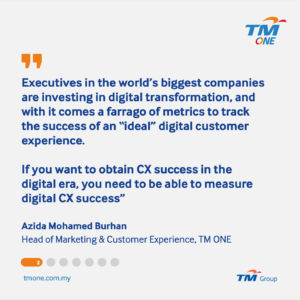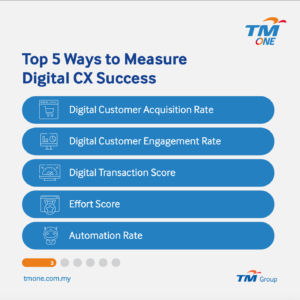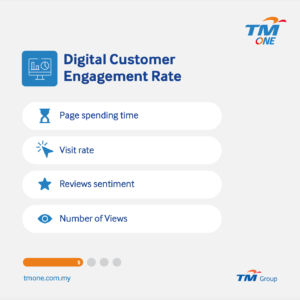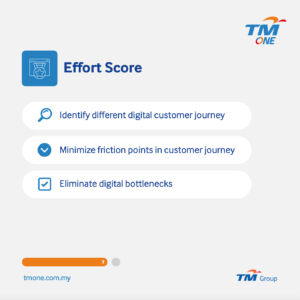
Head of Marketing & Customer Experience
Today, we live in an era driven by customer experience (CX). From booking a flight to having a meal at a restaurant, we have our personal stories that help us form opinions on a brand or business. CX is now the priority for companies looking to set themselves apart from the competition, according to a 2020 survey by SuperOffice.[i] For instance, American Express found that 86% of customers are willing to pay more for a better customer experience, while both PwC and McKinsey researches show that 25% to32% of customers will defect after just one bad experience.[ii]&[iii]
However, measuring the success of digital CX in an age where generic technology-based processes serve customers more isn’t as easy as it seems. Executives in the world’s biggest companies are investing in digital transformation, and with it comes a farrago of metrics to track the success of an “ideal” digital customer experience.
At TM ONE, we believe that “what you don’t measure, you can’t improve”. In our pursuit of building a company centred around delivering the best-in-class digital customer experience, we have compiled five (5) key indicators used by the top CX practitioners in the world to measure the success of digital CX:
1. Digital customer acquisition rate
For digital businesses, measuring their capability of acquiring customers is a great starting point to assess digital CX, which in turn drives long-term growth. Try pondering the question, “how many new purchasing customers have been acquired exclusively online, across all digital channels?”. A case in point is that consumers who enjoy the online experience tend to get converted into customers. Thus, the higher the number of digitally acquired customers, the more likely it indicates a pleasant digital experience.
Besides, measuring digital customer acquisition as a percentage of total customer acquisition will highlight a major difference in the cost of acquisition. The advent of online referral codes and digital personalisation have made it 20 – 50% cheaper for companies to gain new customers (depending on the industry). [iv] & [v] In the long run, studies have also shown that cost of serving digital customers is 20 – 40% lower than those acquired through traditional methods. [vi] This allows companies to shift investments from customer acquisition and focus on boosting digital CX.
2. Digital customer engagement rate
Another great way to gauge digital CX success is to measure online engagement. At different stages of the customer journey, create platform-specific measures to track the progress on driving engagement and the conversion of potential customers through digital initiatives. These measures don’t have to be complicated. Find ways to answer these questions:
- How much time do customers spend on your page
- How many times in a month do customers visit
- What is the overall sentiment of customer reviews
- How many views that the latest video generate
Customers who spend hours looking at products and revisiting the digital catalogue multiple times a day are highly likely to enjoy the digital experience. Pay attention to these metrics to gain a clearer view of how customers feel about their interaction with your brand and, more importantly, their intentions to purchase.

Digital engagement is also a great tool to highlight the segment of your customers that require extra attention. Some companies even take that extra mile to organise digital events and initiate brand ambassadorships. This creates engagement within the community, which improves digital CX and drives digital awareness overall.
3. Digital transaction score
Companies need to take note of the rapid growth in digital transactions and the share of online payments induced by the pandemic restrictions. As businesses go digital, so do their operations and, most likely, how their customers perform transactions. In today’s digital era, customers expect these transactions to be fast and seamless. Take into consideration the share of all transactions performed across all digital channels. Measure the progress made in driving online transactions and simplify the methods for a digital interchange of value. A higher percentage of transactions would indicate that customers are satisfied with the entire user journey, as they see an opportunity for instant fulfilment.
Having measures for digital transactions would also enable a deeper understanding of your online customer’s behaviour. These transactions are valuable sources of information, especially if your company uses analytical tools to dissect and acquire additional insights from your customers. Informed companies can pair that know-how with further investments in specific areas of digital CX.
4. Effort score
In an era where customers perform activities through a few clicks or taps on their devices, companies need to simplify how customers do business with them. A good starting point of measuring digital CX is to identify the different digital customer journeys. Start by creating layers of indicators to measure the efforts taken by a customer to perform a certain service. For example, a bank would measure digital CX by identifying the time taken for a new customer to register for a bank account or how long it takes to resolve different types of customer issues.
Companies need to minimise friction points in customer journeys and look for ways to eliminate the need for any ‘extra effort’ from the consumer’s point of view. The best way to create a successful digital CX is to exceed expectations – whenever and wherever possible. Quickly identify the digital bottlenecks impeding a smooth CX and create a low-effort experience to make life easy for your customers. As Gartner puts it, “effort is the strongest driver for customer loyalty”.[Vii]
5. Automation rate
With millions of transactions taking place per day, it can be hard for companies to keep up and provide the same digital experience across multiple channels. As investments into automation lead to a more consistent digital CX, companies need metrics in place to measure the extent of how automated customer-facing processes are. Chatbots, automated KYC and e-forms are great examples of tools that help drive customers towards a more reliable self-service-based experience. The key here is to identify the extent to which all available customer journeys integrate with automated processes; that plays a crucial role in optimising, standardising, and streamlining digital services.
Nine out of ten world-leading brands use Artificial Intelligence (AI)-based automation solutions to enhance digital customer experience and satisfaction. [viii] Other than the obvious improvements in reliability and simplicity, automation helps reduce labour-intensive processes. This frees up the capacity to deliver more humanised digital CX while setting the foundation for better service personalisation.
Building digital CX success must start with using the right measures
Creating customer-centric businesses take time and effort. Improving this key facet of the business is a marathon, not a race. It is about taking ownership of these measures across a multi-year journey and using them to make informed decisions. Craft an empathetic organisation that cares about how to deliver as much as what to deliver. If you want to obtain CX success in the digital era, you need to be able to measure digital CX success. A fantastic way to start is by using the five key indicators we just spoke about. Read Now










